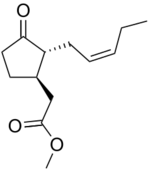جاسمونات المثيل

| |
| الأسماء | |
|---|---|
| اسم أيوپاك
Methyl (1R,2R)-3-Oxo-2-(2Z)-2-
| |
| أسماء أخرى
Methyl jasmonate
| |
| المُعرِّفات | |
| رقم CAS | |
3D model (JSmol)
|
|
| ChEBI | |
| ChemSpider | |
| ECHA InfoCard | 100.013.562 |
| رقم EC |
|
| KEGG | |
PubChem CID
|
|
CompTox Dashboard (EPA)
|
|
| |
| |
| الخصائص | |
| الصيغة الجزيئية | C13H20O3 |
| كتلة مولية | 224.3 g/mol |
| المظهر | Colorless liquid |
| نقطة الانصهار | |
| نقطة الغليان | |
ما لم يُذكر غير ذلك، البيانات المعطاة للمواد في حالاتهم العيارية (عند 25 °س [77 °ف]، 100 kPa). | |
| مراجع الجدول | |
جاسمونات المثيل Methyl jasmonate (ويُختصر MeJA) هو مركب عضوي متطاير يُستخدم في دفاع النبات والعديد من السبل النمائية المختلفة مثل جرثمة البذور ونمو الجذور والإزهار وإنضاج الفاكهة والهـِرم.[1] وتُشتق جاسمونات المثيل من حمض الجاسمونيك والتفاعل يحفزه كربوكسيل مثيل ترانسفيريز حمض الجاسمونيك S-adenosyl-L-methionine.[2] وتنتج النباتات حمض الجاسمونيك وجاسمونات المثيل رداً على العديد من الضغوط الحيوية وغير الحيوية (وخصوصاً، أكل الأعشاب وإصابة النبات بجروح)، وتتجمع المادة في الأجزاء المصابة من النبات. ويمكن استخدام جاسمونات المثيل لإرسال إشارة لأنظمة دفاع النبات الذي يتعرض للعدوان أو يمكن انتشار تلك المادة بالاتصال المباشر أو عبر الهواء لإحداث رد فعل دفاعي في النباتات التي لم تُهاجم بعد. التباتات التي لم ت}ذى بعد تمتص جاسمونات المثيل المحمولة جواً عبر ثغور النبات أو عبر الانتشار الغشائي عبر سايتوبلازم خلايا الأوراق. هجوم أكلة الأعشاب على نبات تجعل هذا النبات يفرز جاسمونات المثيل لكل من الدفاع الداخلي ولإرسال إشارة إلى النباتات الأخرى.[3]
يمكن لجاسمونات المثيل أن تحث النبات على انتاج أنواع متعددة ومختلفة من الكيماويات الدفاعية مثل الألكسينات النباتية (المضادة للميكروبات)،[4] نيكوتين أو مثبطات الپروتينيز.[3] وتتدخل مثبطات الپروتينيز في عملية الهضم لدى الحشرات وتثبط الحشرة من إلتهام النبات مرة أخرى.
ويُستخدم جاسمونات المثيل لتحفيز انتاج أنابيب الراتنج الجرحي في أشجار التنوب النرويجي.[5] ويمكن استخدام ذلك كدفاع ضد العديد من الحشرات المهاجمة كنوع من اللقاح.
وفي التجارب الحديثة، فإن جاسمونات المثيل أظهرت فعالية في منع نمو البكتريا في النبات حين يُرش على الأوراق. المفعول المضاد للبكتريا يُعتقد أنه بسبب حث جاسمونات المثيل للنبات على المقاومة. [6]
MeJA is also a plant hormone involved in tendril (root) coiling, flowering, seed and fruit maturation. An increase of the hormone affects flowering time, flower morphology and the number of open flowers.[7] MeJA induces ethylene-forming enzyme activity, which increases the amount of ethylene to the amount necessary for fruit maturation.[8]
Increased amounts of methyl jasmonate in plant roots have shown to inhibit their growth.[9] It is predicted that the higher amounts of MeJA activate previously unexpressed genes within the roots to cause the growth inhibition.[8]
Methyl jasmonate induces cytochrome C release in the mitochondria of cancer cells, leading to cell death, but does not harm normal cells. To be specific, it can cause cell death in B-cell chronic lymphocytic leukemia cells taken from human patients with this disease and then treated in tissue culture with methyl jasmonate. Treatment of isolated normal human blood lymphocytes did not result in cell death [10]
انظر أيضاً
الهامش
- ^ Cheong, Jong-Joo; Choi, Yang Do (July 2003). "Methyl jasmonate as a vital substance in plants". Trends in Genetics. 19 (7): 409–413. doi:10.1016/S0168-9525(03)00138-0.
- ^ Christie, William W. Plant oxylipins: Chemistry and biology, 22 May 2014. Archived from the original on 2015-06-30. Retrieved on 2017-07-11.
- ^ أ ب Farmer, E. E.; Ryan, C. A. (1 October 1990). "Interplant communication: airborne methyl jasmonate induces synthesis of proteinase inhibitors in plant leaves". Proceedings of the National Academy of Sciences. 87 (19): 7713–7716. doi:10.1073/pnas.87.19.7713.
- ^ Stanley, D. Keeping Freshness in Fresh-Cut Produce, Agricultural Research Magazine, وزارة الزراعة الأمريكية، Feb. 1998. Retrieved on 2010-10-27.
- ^ Martin, D.M., Gershenzon J. and Bohlmann J. Induction of Volatile Terpene Biosynthesis and Diurnal Emission by Methyl Jasmonate in Foliage of Norway Spruce, Plant Physiology, 2003. Retrieved on 2016-09-01.
- ^ Luzzatto, T., Yishay, M., Lipsky, A., Ion, A., Belausov, E. and Yedidia, I. Efficient, long-lasting resistance against the soft rot bacterium Pectobacterium carotovorum in calla lily provided by the plant activator methyl jasmonate. Plant Pathology, 56(4):692-701, Aug 2007. DOI:10.1111/j.1365-3059.2007.01622.x. Retrieved 2017-07-11.
- ^ Radhika, V., J. Cost, W. Boland, and M. Heil. The role of jasmonates in floral nectar secretion. PLOS ONE. 2010. DOI:10.1371/journal.pone.0009265 Retrieved on 2010-10-27.
- ^ أ ب Berger, S.; Bell, E.; Mullet, J. E. (1 June 1996). "Two Methyl Jasmonate-Insensitive Mutants Show Altered Expression of AtVsp in Response to Methyl Jasmonate and Wounding". Plant Physiology. 111 (2): 525–531. doi:10.1104/pp.111.2.525.
- ^ Wasternack, C. Jasmonates: An Update on Biosynthesis, Signal Transduction and Action in Plant Stress Response, Growth and Development. Annals of Botany (2007) 100(4):681-697. DOI:10.1093/aob/mcm079. Retrieved on 2010-10-27.
- ^ Rotem, R., A. Heyfets, O. Fingrut, D. Blickstein, M. Shaklai, and E. Flesher. 2005. Jasmonates: novel anticancer agents acting directly and selectively on human cancer cell mitochondria. Cancer Research 65(5):1984-1993. DOI:10.1158/0008-5472.CAN-04-3091. Retrieved on 2010-10-27.
وصلات خارجية
- General information about methyl jasmonate
- Jasmonate: pharmaceutical composition for treatment of cancer. US Patent Issued on October 22, 2002
- Plant stress hormones suppress the proliferation and induce apoptosis in human cancer cells, Leukemia, Nature, April 2002, Volume 16, Number 4, Pages 608-616
- Jasmonates induce nonapoptotic death in high-resistance mutant p53-expressing B-lymphoma cells, British Journal of Pharmacology (2005) 146, 800–808. DOI:10.1038/sj.bjp.0706394; published online 19 September 2005
- Articles with changed EBI identifier
- Articles with changed ChemSpider identifier
- ECHA InfoCard ID from Wikidata
- Articles with changed KEGG identifier
- Articles with changed InChI identifier
- Articles containing unverified chemical infoboxes
- Chembox image size set
- Short description is different from Wikidata
- Acetate esters
- هورمونات نباتية
- كيتونات
- مشتقات الألكينات
- Methyl esters